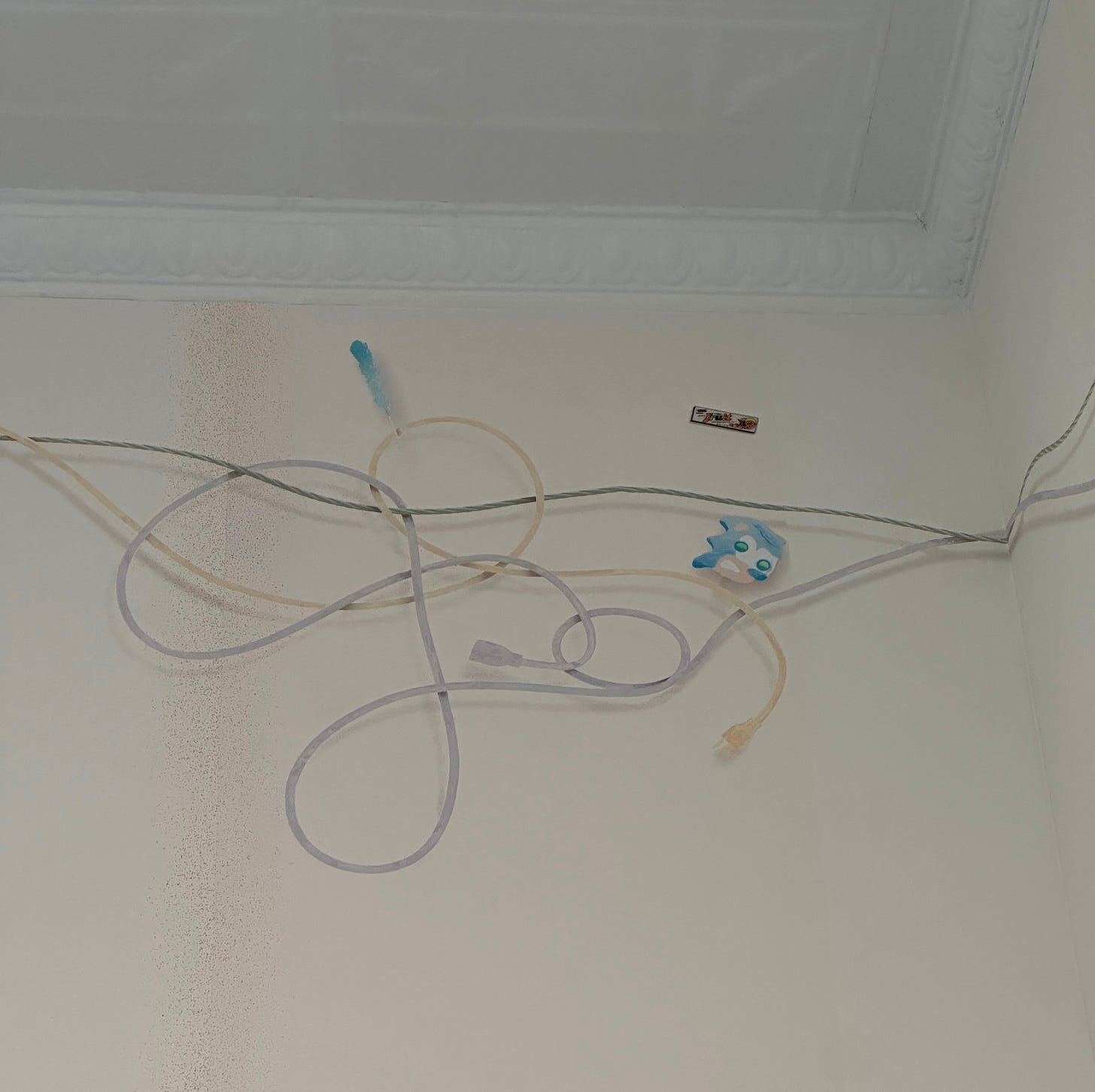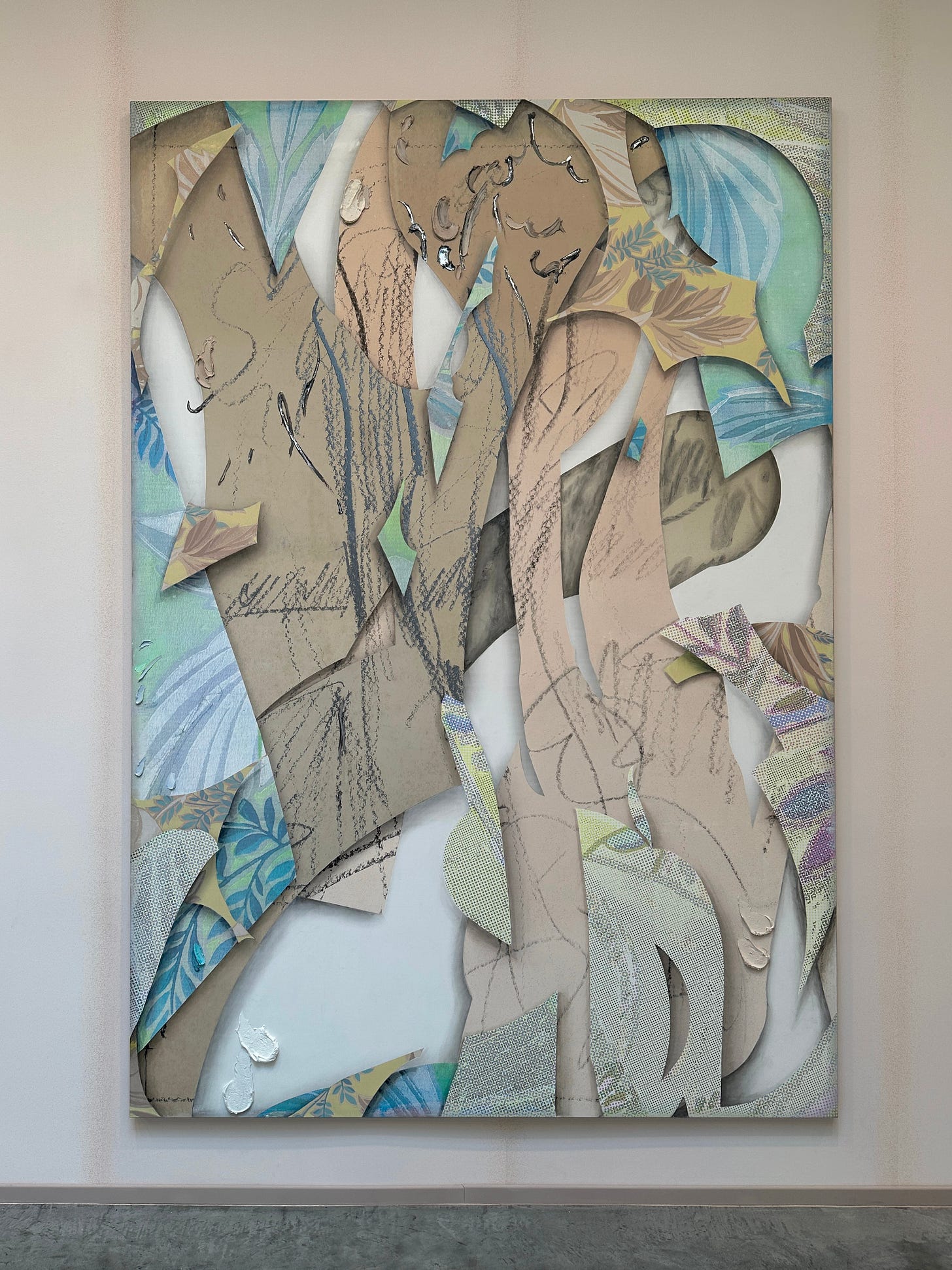At the entrance to the first main room of paintings at the Laura Owens exhibition at Matthew Marks Gallery in Chelsea, at the margins both of sight and of the exhibition, there is an illusionistic Sonic the hedgehog popsicle tangled in electric cables painted on the wall, almost at the ceiling. It’s not catalogued as an artwork on the exhibition checklist. The walls of the room are towards the ceiling, where a frieze would be, are painted with snaking cables with fake shadows, and treats—bubble gum, a choco-taco, a bugs bunny popsicle, black and white cookies. Even the least consequential bits of the exhibition relish in surprise, illusion, and the pleasure that comes from viewing a painting.
This is Owens’s first solo show in New York in eight years and it spans two galleries, 522 and 526 W 22nd St. It’s the first opportunity I’ve had to see a group of her works in person outside of scattered paintings in group shows. Obviously, any work of art is best seen in person, especially so with Owens, whose work, as Mark Godfrey suggests, “insists on the importance of material gestures in real space.”[1] Put more simply, there are things you won’t notice if you just look at pictures. You also won’t notice them if you look in person but don’t look long enough.
The works on view here seem especially important to see in person. They cover entire rooms, and they make use of wallpaper patterns, but they sidestep decoration. They employ moving elements and sound while dodging theatricality. They make use of almost every conceivable material—one work is categorized as “oil, acrylic, silkscreened Flashe, and flocking on clay-coated paper mounted to aluminum panels, egg tempera on panel, video, and sound”—but they resoundingly speak the language of painting. Specifically, that of cubism and cubist collage.
When Godfrey wrote the above quotation about material gestures in 2014, he was commenting on her “Pavement Karaoke” series, a group of seven related canvases intended to be shown together, which make use of a variety of techniques including digital tools and impasto. One of the major gestures in the series involved using a computer program to draw big, perfect squiggly lines, the kind that could only be made by a machine. The lines were then projected on the canvas where they were painted by hand in impasto, a thick buildup of paint. In addition to drawing a contrast between the material handmadeness of the visible paint and the seamlessness of the squiggly line shape that contains them, the paint is applied thickly enough to cast its own shadow, which she contrasts with fake, painted drop shadows. In the same piece I quoted from earlier Godfrey elaborates: “The impression of fakeness is amplified by the illusionistic drop shadows she paints in to accompany the real shadows cast by the physical crests.”[2] I think of this combination of techniques and Owens’ other applications of shadow in relation to the picture plane as a kind of software update for cubist collage for the era of photoshop.
Picasso and Braques’ shadows loom over almost anyone who takes painting seriously, but I think the comparison is especially apt here, for the “Pavement Karaoke” works, and even more so for the paintings in the current exhibition, which I know I still haven’t really gotten into yet. Cubist collage, which began in 1912, likely with Braque’s application of woodgrain paper to a still life, increasingly incorporated disparate elements like bits of paper, wallpaper, trompe l’oeil lettering, and fabrics into modernist painting. Clement Greenberg (I’m sorry but he was right about cubism) wrote a description of the play between actual and illusionistic shadow on the surfaces of the cubist collages of the 1910s, which strikes me as similar to Godfrey’s description of Owens’ paintings:
“The area adjacent to one edge of a piece of affixed material—or simply of a painted-in form—will be shaded to pry that edge away from the surface, while something will be drawin, painted or even pasted over another part of the same shape to drive it back into depth.”[3]
We don’t have to stay on cubism for too much longer, but to put an image to the comment, one could consider Picasso’s Dice, Packet of Cigarettes, and Visiting-Card in the Yale collection. It’s an interesting picture worthy of further analysis, but what’s relevant to my point is that he glues Gertrude Stein and Alice B. Toklas’s actual visiting card to the picture surface, so the bottom edge is raised from the surface—it’s glued on top of it. Picasso then cut off the corner of the card and shaded it to look like it had been bent. So, there is both an actual shadow in the way the card is slightly raised from the surface, and the artificial shadow of the drawn on bent corner. The corner is shaded to make it look like it’s peeling away, but the bottom end of the card pushes the illusion back into place.

The new exhibition develops Owens’ use of impasto and drop shadow to an unprecedented scale. Her work, which is documented by date in its entirety on her website, bibliography and all—a testament to her meticulousness—has steadily increased in scale. In the 2010s her paintings began to extend to screens, walls, and eventually full rooms. Paintings become parts of fences, or act as decorative friezes on walls, touching the margins of a room, much like the tangled electric cables and popsicles. One technique masquerading as another develops as a coherent theme. A silkscreen that looks like an oil, for example. The dominant attitude is one of playfulness, not in the sense that the works themselves seem experimental, they are generally rigorously finished in appearance. It’s more like they announce that you can take ideas about illusion and painterly space seriously, see them through to the highest level of execution but still have fun with it. Which sounds corny as I type this but I’m struggling to think of a better way to phrase it.
Okay, the overview. The installation at the gallery at 522 W 22nd St. includes the entrance, which has a desk that is part of the exhibition. Then a room with four large vertical wall works and the electric cables and stuff. This would be impressive enough. Two hidden doors lead to a third room, classified on the checklist as entirely one work, leading to a small niche behind another hidden door with a raised screen you crane your neck to look at showing an animated video by the artist. The video work is engaging on its own, but it seems more like a justification to keep people waiting in the room, looking at the work. A line queues up for the video, and only a few people can see it at once. The video runtime is about 16 minutes, and most people don’t watch the entire video, but since access is so limited, there’s a lot of time to look at the walls, which endlessly reward close observation.
The exhibition continues at 526 W 22nd St. with a room of five custom boxes with various little compartments that resemble modern Kunstkammers. The drawers contain artists books, which viewers are encouraged to open and flip through, adding a tactile component to the exhibition. Behind the books, there is another door leading to a second cotton candy colored room of all-over multimedia painting and a sound element. Despite the efforts to engage the viewer, the all over painted rooms, the sound and multimedia elements, it doesn’t land as cheapened or spectacularized, just unpretentious and omnivorous.
In this exhibition there is always another detail, always another passageway, always another cabinet. Scale ranges from the handheld level of artists books to the enveloping scope of the full rooms. Inside the rooms, it is as though you are looking out at a painting from the point of view of being inside of the artwork. What’s most impressive is that everything gels together thematically and compositionally across these scales (cubism famously didn’t hold at larger scales or in brighter palettes). The show is animated by a spirit of exploration or unfurling, by a sense of infinite layers. It is also animated by gleeful illusion—Russian nesting dolls of trompe l’oeil tricks. 1000 layer art bean dip.
There’s so much to take in that it’s difficult to find an angle to talk about specific works. Maybe it would be beneficial to do a close reading of one of the wall works in the exhibition first and then to try to elaborate on the centerpiece of the show, which is the full room behind the hidden door at 522 W 22nd St.
The painting I want to discuss is untitled, from 2025 and makes extensive use of disarming drop shadows, disorienting confusion of medium and pictorial space, and impasto. It looks like a floating collage of cardboard and wallpaper, accented with graphite and pastel. The combination of silkscreen and oil gives the work the look of a series of cut outs exposing successive layers. What appears to be solidly primed canvas gives away to what appears to be a layer behind the canvas, but at a closer look, everything is happening on top of the picture plane. Because some of the shadows are painted, some of them are more crisply silkscreened, and some of them are literal shadows from the thick globs of impasto, it creates tension in its instability. Each element’s assertion of space seems to deny the certainty of the other layers’ spatial status. A shape that appears to be under is actually over, or vice versa.
The large room is a continuation of the ideas expressed in the paintings with a fanatical all-overness. There are large, cloudlike shapes of shimmering, papery elements. There are cutouts of green gridded wallpaper with little bits of green impasto camouflaged inside of them. Periodically, little mechanical panels will open from the wall and expose another layer of painting underneath the painting. There are childlike trees in thickly impastoed paint towards the bottom of the room. Along the top, slivers of Day-Glo orange yellow and magenta peek out through the cracks. We know that it’s done with a combination of painting and printmaking, and that photoshop is probably involved in the construction of layers, but it’s sort of impossible to imagine how the work, the room, was conceived, and more difficult to imagine how it was actually constructed. Like Owen’s earlier works, there’s a play of obvious assertion of the human hand in the dabs of visible paint, and the hiding of the works fabrication in the seamlessness of its other components.
The show is baffling, disorienting, and meticulous. It’s also really, really fun.
[1] Godfrey, Mark, “Statements of Intent,” Artforum, April 2014, p. 302
[2] Godfrey, p. 298
[3] Greenberg, Clement, “Collage,” reprinted in Art and Culture, 1961, p. 77










